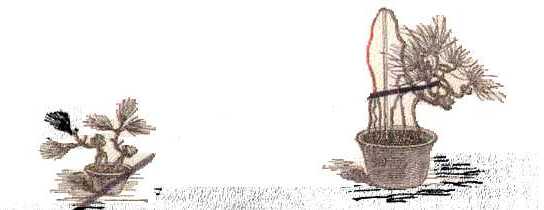"In that fascinating nightmare, L'Homme qui Rit, Victor Hugo tells
us that in the seventeenth century there existed in Europe a band of nomads, known by the name of
comprachicos, or children buyers, whose special
handicraft was the transformation of their unhappy purchases into dwarfs and monsters for the particular
delectation and amusement of popes and princes. In the nineteenth century, in our own corner of the world,
at any rate, the comprachicos are luckily as obsolete as the rack and the thumbscrew; but the practice of
interfering with Dame Nature in her benevolent occupation of strewing our path with things of beauty which are
joys for ever still thrives in Japan. The daimios of Yokohama and Nagasaki are not content with the
countless beautiful gems of the plant world with which their favoured islands are studded, but they must also
have dwarfs and monsters of the vegetable kingdom. They must have Pine trees with the best part of their
roots leaping up into the air several feet higher than their topmost twigs, or Kakis with their branches so
contorted as to resemble tangled masses of cordage instead of the graceful trees which we know them to be.
In the 'Revue Horticole' for July 16, Mons. E.A. Carrière gives a long and
interesting account of the dwarf and monster plants shown in the Japanese section of the Paris Exhibition.
These vegetable abortions [sic] have hitherto only been known to us through the
medium of the metal and fictile wares of that wonderful country.
|
Fig. 1.--Two young plants of Pinus densiflora, deformed.
|
Fig. 2.--Specimen of Pinus densiflora, with the larger
portion of the roots growing in the air.
|
M. Carrière admits at starting that he can only guess [sic]
at the methods used by the Japanese comprachicos for producing these vegetable
monstrosities, which not only include dwarf plants, but also shrubs and
bushes of tender years, which wear a feeble and venerable appearance long
before the natural time. Figs. 1, 2, and 3 are good examples of this
peculiar development of the art of horticulture. M. Carrière
supposes that when the Japanese wish to dwarf any particular subject they
naturally choose those varieties which most lend themselves to being checked
in their growth by various means. By training their shoots, and branches
with the utmost patience, they are able to produce the most monstrous forms,
while by limiting the amount of nourishment which the plants receive within
the narrowest possible limits they become dwarfs. Hence, by adopting
the latter method, of checking their growth, they succeed in producing
plants which, although they may be over a century old, are still small
enough to live and thrive in a medium-sized flower-pot. We must also
remember that the climate of Japan is peculiarly favourable to this description
of horticulture, and it is doubtful [sic]
whether this kind of culture could be carried out in hot, dry, sunshiny
countries. Of all hardy subjects the Conifers seem to have produced
the most successful specimens of dwarfs and monsters, either because they
are more fitted for this mode of treatment, or because they are more in
favour in Japanese gardens. Amongst the Conifers again Pines seem
to produce the happiest results. As seen in figs. 2 and 3, the stem,
which is reduced to its very simplest expression, grows at a distance from
the surface of the soil, and is supported by a number of simple or branched
roots supported by sticks, which float about in the air as if they belonged
to it. The results shown in figs. 1, 2, and 3 are difficult to explain,
especially that which, as will be seen, sends up a root from b,
which, bending round in the form of a syphon at a distance of 2 ft. or
3 ft. above the plants, descends once more as far as a, where it
splits into a number of branches, if such a word may be applied to a root,
and descends into the soil contained in the pot, whence it conveys nourishment
to the plant by the circuitous path shown in the cut. In the majority
of cases it is difficult to fix the exact spot at which the root ends and
the stem begins, as they seem to run into each other. If we carefully
examine fig. 3 we shall apparently find that the end of the root-stalk
is at a, and that from thence to the point b, where the cotyledons
formerly existed, the part may be considered the collar, so that below
this point we may still find a portion of the root-stalk, which, becoming
thinner, is easily confounded with the roots properly so called.
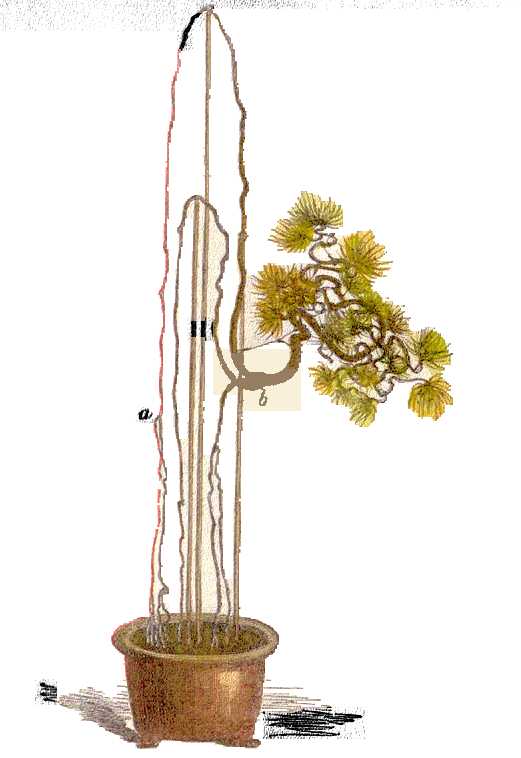
|
|
Fig. 3.--Pinus densiflora, submitted to the same
treatment as the specimen shown in fig.2 (1-8th the natural size).
|
As shown in figs. 4, 5, and 6, the branches and shoots constituting
the head of the tree may be contorted by training into the most extraordinary
dwarf and monstrous forms; in fact, everything is done to prevent them
from growing in a vertical or horizontal direction. This system of
cultivation seems to be very widespread throughout Japan, and must be practised
by a large number of persons, for such specimens as the one shown in fig.
1 are exhibited by hundreds. Worried literally half out of their
lives by ill treatment and starvation, it is not to be wondered at if the
size of some of these unhappy victims are wholly out of proportion to their
age. For instance, the puny-looking plant shown in fig. 1 is ten
years old, while that represented in fig. 2 has seen at least eighteen
summers; and the Pinus in fig. 3 nearly trebles that age. The monstrosity
shown in fig. 4 is thirty-four years old, and the Nageia (fig. 5) is only
five years younger. These ages, it must be observed, are only approximative.
Although the Pines seem to be particularly amenable to this mode of treatment,
there are other members of the family of the Coniferæ which are also
capable of gratifying the perverted tastes of the Japanese aristocracy,
such, for instance, as the Chamæcyparis, the Podocarpus, and even
the Nageia (as shown in fig. 5).
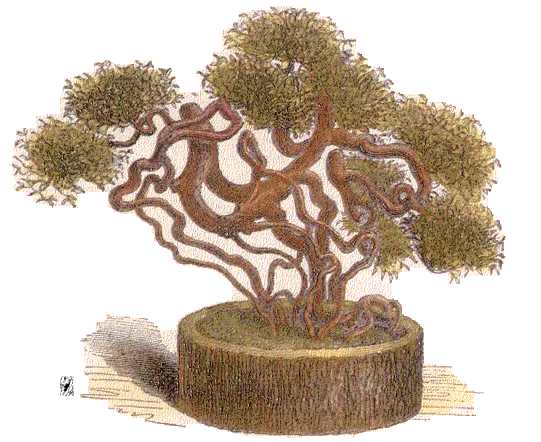
|
|
Fig. 4.--Stunted and deformed specimen of Rhynchospermum
japonicum.
|
It is clear that other species of Coniferæ may be submitted to
the same process with similar results. This peculiarity of the Coniferæ,
no doubt, is caused by the fact of their having excessively long roots,
as any one who has grown Pines in pots can readily testify. Without
positively asserting anything, M. Carrière gives it as his opinion
that the whole secret lies in the choice of subjects with extremely long
roots; and in support of it he instances the fact of a seedling Cedar,
which was sown in heat in a tube containing Moss, out of contact with the
air, and which, in a very short time, produced roots 18 in. or 20 in. in
length. It must also be remembered that as the Japanese do all they
can to check the growth of the aërial half of the plant, the subterranean
portion must necessarily become unnaturally developed. The singular
results shown in figs.1 and 3 lead one to inquire as to whether the effects
are obtained before or after the plants are placed in pots.
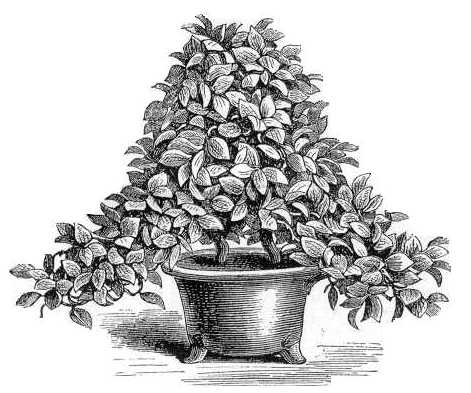
|
|
Fig. 5.--Nageia ovata in a Japanese flower-pot, with
the branches growing downwards (1-8th the natural size).
|
Be this as it may, it is perfectly evident that some means are taken
to draw the roots out of the soil gradually, without in any way damaging
the rootlets, so as to expose all their ramifications to the air, leaving
only a small portion of their extremities in the soil. It is not
only in ornamental plants that the Japanese Comprachicos work their wicked
will, for they apply the same system of dwarfing to fruit trees -- first
of all in a natural way, by tying the branches together in such a manner
that they grow inwards instead of outwards; and, secondly, in an unnatural
manner, by excessive pruning, or by checking their growth one way or another.
Judging from the specimens shown in the Trocadero and at the Jardin Fleuriste,
the fruit trees best adapted for this method of treatment seems to be Kakis,
Peaches, Plums, and Cherries. The Kaki seems to be designed by Nature
for the especial purpose of being dwarfed and otherwise deformed.
Some of the specimens exhibited are very dwarf, being only from 16 in.
to 30 in. in height, but they are covered with flowers, and, judging from
the condition of the shoots, they must have fruited abundantly. In
growing fruit trees, the Japanese follow the method adopted by our western
fruit growers, and leave only from six to twelve fruits on each tree, according
to its natural vigour. Another peculiarity of these dwarfed and deformed
trees is that their roots, as a whole, are very small, the subterranean
portions being comprised in a few small tufts of rootlets.
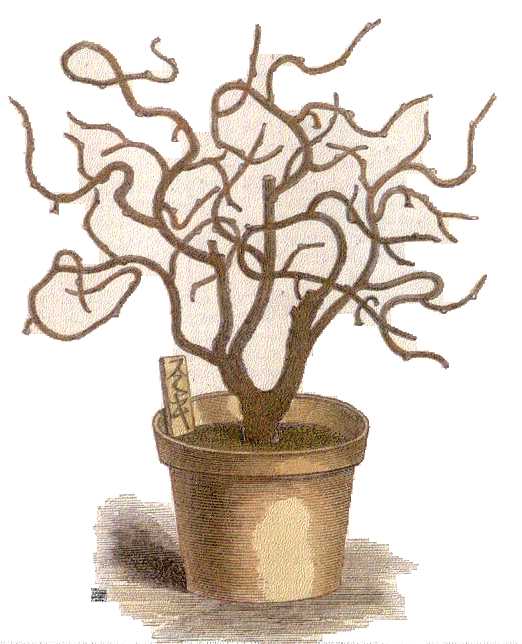
|
|
Fig. 6.--Full-grown Kaki, with the branches deformed
by pruning and training, bearing here and there fructiferous peduncles.
|
It is impossible to say whether this is the result of checking the growth
of the aërial part of the plant or of perpetual transplanting, so
as to keep the subject, so to speak, in a constant state of ill-health.
In the absence of any trustworthy information on the subject, we can only
surmise that both these methods are practised.
C. W. QUIN 1
|
